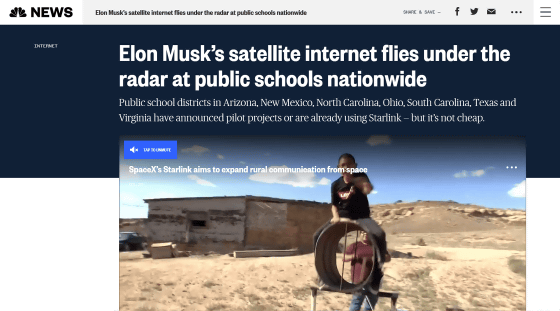SpaceX's satellite Internet 'Starlink' is beginning to be introduced in rural public schools

SpaceX, a space development company led by Mr. Earon Mask, is developing a satellite Internet service '
Elon Musk's satellite internet flies under the radar at public schools nationwide
https://www.nbcnews.com/tech/internet/elon-musks-satellite-internet-flies-radar-public-schools-nationwide-rcna44318

Starlink uses a large number of dedicated satellites and terrestrial antennas to provide Internet services to remote areas, ships , and airplanes where Internet infrastructure is inadequate. In addition, Starlink became a hot topic when it became available in Ukraine, which was invaded by Russia.
Satellite Internet services are in great demand in the United States, which is a large country and has many areas with poor Internet infrastructure. According toa survey conducted in 2021 by BrodbandNow , an Internet industry research organization, 42 million people in the United States do not have access to broadband Internet that can be used for live streaming and video chat.
Typically, filling these gaps in internet infrastructure requires investing in long-term construction projects to install new cables to remote locations. However, such infrastructure construction takes a long time, so it is not a quick solution.
Meanwhile, when the pandemic of the new coronavirus infection (COVID-19) occurred in 2020, many schools were closed and forced to switch to remote education. However, it is not easy for people who live in remote areas and do not have sufficient internet access to take remote classes through the internet. Starlink was the fastest option for such people to get enough internet access, just by installing an antenna.
At the time of writing, public school districts in Arizona, New Mexico, North Carolina, Ohio, South Carolina, Texas, and Virginia have announced or have already introduced Starlink. ``Starlink clearly offers more choices in many places, especially in rural America,'' said Evan Marwell, CEO of EducationSuperHighway, a non-profit organization that supports high-speed Internet access in schools. 'I wouldn't be surprised if there were a million or more households that could be the solution.'
In August 2022, Starlink was hit by a $900 million (approximately 130 billion yen) subsidy application from the US Federal Communications Commission (FCC) that was rejected for ``not achieving the internet speed that satisfies the requirements''. received. Meanwhile, Starlink also benefits from providing Internet services to many residents in partnership with remote schools.

However, the problem with the partnership between the school and Starlink is, 'Can Starlink be a sustainable solution?' To use Starlink, you need to purchase a set of equipment including an antenna for $ 599 (about 86,000 yen) and pay a monthly fee of $ 110 (about 16,000 yen). In order to fill the gaps in the Internet infrastructure that has suddenly emerged, even if the initial purchase of equipment and temporary payment of fees are borne by the government, it is difficult for the government to bear the costs permanently.
For example, in Southwest Virginia, approximately 640 students in approximately 400 households across multiple counties use Starlink's satellite Internet service through the local school system. “We needed a solution for our students now,” said Scott Kiser, director of school technology for Wise County, Virginia. I'm here.
The Virginia state government spent 500,000 dollars (about 72 million yen) to bear this cost, and also used the costs contributed by each county to sign a two-year contract. However, after this contract ends, you cannot use the Internet unless you pay the fee again.
In addition, approximately 700 students in approximately 400 households in the Cuban Independent School District in northern New Mexico have started using Starlink services using federal COVID-19-related relief funds. Some students live more than 50 miles (about 80 km) from the school, so access to high-speed Internet is very important. However, technical director Tim Chavez said, ``Students who currently access the Starlink Internet are not necessarily wealthy.'' I don't know if I can do it,' he said.

Starlink sales manager Bianca Reinhardt admitted in an interview with NBC News that partnerships with school districts and counties have become a priority for the service since the COVID-19 pandemic. 'Schools were actually closed, so students needed internet at home in order to participate in school,' he said. We are focused on what we do,” said Reinhardt. “As a company, I think we have a track record of always trying to keep costs down,” said Lauren Dreyer, senior director of business operations at Starlink. suggested.
Of course, if land-based Internet infrastructure is available in remote areas, users may switch to other options in consideration of Internet speed and fees. However, some Starlink users are satisfied with the Internet speed. 'If fiber is extended to this area, depending on the price, I'd consider switching,' said Brandon Honaker, a Starlink user in Tazewell County, Virginia. 'But honestly, Starlink does everything we need.' I will do it, ”he commented.
Related Posts:
in Web Service, Posted by log1h_ik







